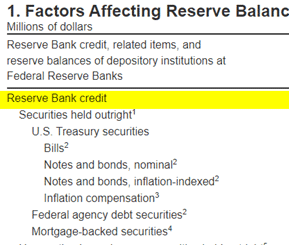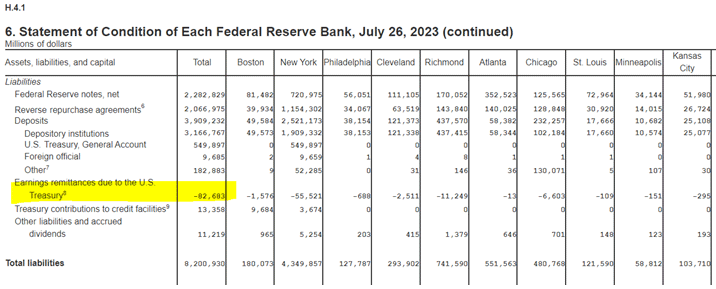The Fed Is Operating at a Loss. What It Means for Stocks, Banks, and Your Money
The Fed is already operating at a loss from reductions in its balance sheet. And it’s one that has been growing since September 8, 2022. In fact, the last time the Fed reported a slight gain was in its September 1, 2022 H4.1 report. The Fed releases its H4.1 report every Thursday. Most people pay no attention to it. I do.
Jason T.
8/5/20233 min read
And I can tell you that, on July 27, 2023, the Fed was showing a loss of about $82.7 billion.
Now, the Fed doesn’t go about discussing its losses at its FOMC meetings or the Q&A with Fed Chairman Jerome Powell that follows them. And no reporter asks.
Plus, you need a magnifying glass to even find this loss on the H4.1 report.
For those of you that want to see for yourselves, click here to open the Fed’s H4.1 report from July 27, 2023.
At the left of the top line of numbers, you can see the Fed holds $8.2 trillion in a category called Reserve Bank Credit
In layman’s terms, that’s the amount of money the Fed has printed and given to banks in return for Treasuries and other bonds via quantitative easing (QE).
To be clear, the Fed is not selling bonds. It’s merely not buying new ones to replace the ones that are maturing.
And before the Fed began raising rates last March, which was several months before it started this mild version of QT, the size of its book hit a record high near $9 trillion.
So at this point, the Fed has only “QT’d” about 9% of its entire balance sheet. That's not a big deal. And this is by design.
The Fed doesn’t want to fire-sell a large chunk of the bonds it’s holding, and the banks don’t want to give the Fed its money back.
THAT could create a bond market and bank collapse.
Now, if you keep scrolling down at that link above, you’ll reach item box 6: Statement of Conditions. In that box, the line that says “Earnings remittances due to the U.S. Treasury” is the key…
In its first column, there’s that $82.7 billion number I mentioned earlier. And there’s a tiny superscript eight there.
If you scroll down to see what eight means, you’ll see four lines of accounting jargon.
In plain English, it says that the Fed remits excess money to the Treasury from its operations each week, if it has any excess money. If it doesn’t, the Fed is operating at a loss.
Today, the Fed is operating at a loss.
It’s not making enough money to pay the Treasury anything. That’s because the value of its U.S. Treasuries is lower (and the rates higher) than the Treasuries that are maturing.
Now, because it’s the Fed, no one cares.
The Treasury knows the Fed can print money whenever it feels like it to cover payments, anyway. And no one is going to charge the Fed late fees on the money it’s not paying the Treasury, either.
Yet, because of the Fed’s tightening policy, the amount of interest the government must pay on the money it borrows in the form of Treasury bonds has increased. The value of those Treasuries has gone down in tandem.
So the nation is operating on record debt and a deficit, and the Fed is operating at a growing loss.
Which takes me back to the rest of your questions.
I can assure you that the banks aren’t sharing the Fed’s losses. They aren’t obligated to remit money to the government like the Fed is – except in the form of taxes. But that’s a whole other story.
In terms of how this effects the stock market – it doesn’t.
As I mentioned, the Fed’s been operating at a loss for nearly a year. The stock market has been rallying much of that time, save last fall.
And then, it was more worried about when the Fed would pause its rate hikes than whether the Fed was losing money because of its own polices.
Now, I can’t give personalized advice. But what I’ll say to all my readers is this:
Step 1 – Ignore what’s happening with the Fed’s QT process. It’s slow and has a marginal impact, if any, on the market.
Step 2 – Diversify your portfolio into hard assets like gold. Sprinkle in a finite asset such as Bitcoin. And select commodities and stocks in sectors that provide real, lasting-use value – such as in the energy sector.



